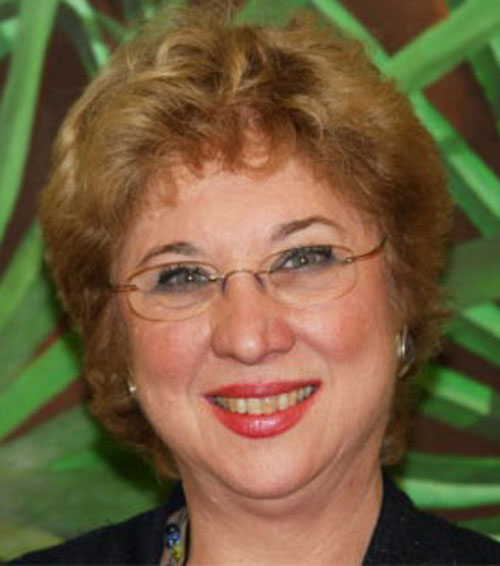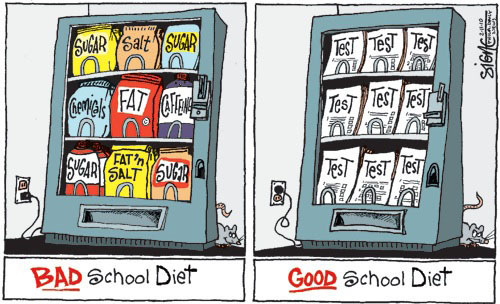CLASS SIZE MATTERS (at least in Florida)... Florida voters continue to support reduced class sizes in public schools
For more than 20 years, Chicago teachers have known that in Florida, by law, class sizes in public schools are capped at a certain level, as are the total student loads (for high school teachers). Back in the mid-1980s, after the earlier bankers' attack on the public schools of Chicago yielded the School Finance Authority and a billion dollar debt to the banks (then led by Salomon Brothers of "Liar's Poker Fame"), a number of Chicago teachers went to work in Florida. One former Substance staff member, Gwen Brenner, wrote to us often from Fort Pierce, where she moved to teach English (after working at a dozen Chicago high schools, including Juarez and Dunbar, where our paths crossed when I was on the road as an FTB).
 Karen Aronowitz, President of the Miami teachers union, spoke forcefully in favor of the class size cap in Florida. Gwen told me that by law high school English teachers could have no more than 100 students (total) because the law was written by people who knew that you couldn't teach writing without having young people write, and that writing teachers needed the time to read everything the young people wrote.
Karen Aronowitz, President of the Miami teachers union, spoke forcefully in favor of the class size cap in Florida. Gwen told me that by law high school English teachers could have no more than 100 students (total) because the law was written by people who knew that you couldn't teach writing without having young people write, and that writing teachers needed the time to read everything the young people wrote.
The class size program, which began by law in the 20th Century and became part of the Florida Constitution in the 21st Century, was based on a broadly shared common sense approach to education — and support for public education — that persisted into the era of Arne Duncan, the Obama administration's attack on public schools, and "Waiting for Superman." After the most recent skirmishes in Florida about class sizes and the law, Florida plutocrats claimed that the public "didn't understand."
It was the plutocrats and their allies who don't understand. As the article in the Miami Herald (see below) indicates, school administrators and their political backers simply ignore the obvious. As readers can see, one administrator argues that some student somewhere will be "denied" the chance to take an Advanced Placement class because the class size has been capped at 25. What is always left out of these arguments, both in Chicago and elsewhere, is the simple solution of brining in another classroom teacher, thereby giving the principal even more flexibility to offer even more elective choices for the students or children in the school.
 Maimi Dade teachers in bargaining session in October 2010.In Chicago, while pummeling principals and teachers from the narrow prism of the bottom line of a spreadsheet, outgoing "CEO" Ron Huberman ruthlessly cut teachers — while expanding the number of mindless bureaucrats in the "Office of Performance Management" (at the central office) and in the "Area Offices" by nearly $100 million (that's right, $100 million in two years). Teachers in Chicago were fired so Huberman could hire hundreds of people with no teaching experience (and usually either MBA or JD degrees) as overseers on the ever-expanding Performance Management plantation, Chicago's newest version of Plantation Politics.
Maimi Dade teachers in bargaining session in October 2010.In Chicago, while pummeling principals and teachers from the narrow prism of the bottom line of a spreadsheet, outgoing "CEO" Ron Huberman ruthlessly cut teachers — while expanding the number of mindless bureaucrats in the "Office of Performance Management" (at the central office) and in the "Area Offices" by nearly $100 million (that's right, $100 million in two years). Teachers in Chicago were fired so Huberman could hire hundreds of people with no teaching experience (and usually either MBA or JD degrees) as overseers on the ever-expanding Performance Management plantation, Chicago's newest version of Plantation Politics.
Since those days, assorted government officials (most notably Jeb Bush, brother of George W. Bush) tried to abolish Florida's class size law, saying it was "inefficient." Their latest attempt was on November 2, 2010, and once again the voters rejected it. The following story, forwarded by Norm Scott of ICE (New York teachers) tells that latest chapter in that story, courtesy of the Miami Herald. Readers who want to know more about class size issues can Google around, although for years the best place to begin has always been the New York City group "Class Size Matters" (see below).
The irony for me was striking today, the day after many of us paid for a lot because Barack Obama betrayed those who elected him on a number of fronts, most notably for teachers, by putting Arne Duncan in charge of corporate "education reform" and implementing the Chicago Plan to privatize public schools and bust the teachers unions. On November 4, 2010, as part of my work for the Chicago Teachers Union, I was on a team investigating class size problems at Chicago's huge Schurz High School, a general high school that, like all of Chicago's general high schools, has been sabotaged since Arne Duncan became Chief Executive Officer of CPS in 2001 by the Ayn Ran cult of efficiency. There are teachers at Schurz in regular subjects today with more than 150 students (in all of their classes) and some with more than that. Yet Ron Huberman was trying to reduce the number of teachers at that school, under the obscene formulas for efficiency that spin out of the minds of those who — like Huberman, Obama, and Duncan — have been spending too much time with spreadsheets and in Ayn Rand study groups and no time in real classrooms and schools with real children and teenagers in some of America's most heartbreaking and challenging communities.
Enough. Enjoy the following article, which follows Leonie's observations.
FROM CLASS SIZE MATTERS.
On Thu, Nov 4, 2010 at 3:05 PM, Leonie Haimson wrote: Where ever there are referenda — and they don’t allow them in NY State — the teachers unions, PTAs, and civil rights organizations should together organize to put similar questions on the ballot.
Expect an even stronger push back from the pro-privatization, anti-funding crowd against this issue, however. With a mandate to reduce class size, they are aware that pressures for more funding would grow even stronger, and the move towards privatization would considerably weaken.
Leonie Haimson
Executive Director
Class Size Matters
124 Waverly Pl.
New York, NY 10011
212-674-7320
classsizematters@gmail.com
www.classsizematters.org
http://nycpublicschoolparents.blogspot.com
http://www.huffingtonpost.com/leonie-haimson
FROM THE MIAMI HERALD
CLASS-SIZE AMENDMENT....Florida voters reject class-size changes.... Voters have spoken now -- twice. Whatever the cost, they want smaller classes.
BY KATHLEEN McGRORY AND CARLI TEPROFF. Miami Herald, November 3, 2010. http://www. miami herald.com/2010/11/03/v-fullstory/1905847/voters-reject-class-size-changes.html. University of Miami journalism student Elissa DeCampli contributed to this report. Read more: http://www.miamiherald.com /2010/11/03/v-fullstory/1905847/voters-reject-class-size-changes.html#ixzz14KK4Fptf
Florida voters reaffirmed their commitment to small class sizes on Tuesday, defeating a Constitutional amendment that would have relaxed the rules on how many children may be in a classroom. It was a victory for parent and teacher groups, which had lobbied to keep the existing class-size rules in place. Loosening the regulations, they argued, could mean less state funding for education.
"The people of Florida made it clear that they want smaller classes,'' said United Teachers of Dade President Karen Aronowitz. "Now, the Legislature has to find the money.''
 A cartoon that began making the rounds on Election Day.Added Broward Superintendent Jim Notter: "It's the first indicator of a groundswell to hold the state accountable, once and for all, for adequately funding public education.''
A cartoon that began making the rounds on Election Day.Added Broward Superintendent Jim Notter: "It's the first indicator of a groundswell to hold the state accountable, once and for all, for adequately funding public education.''
Florida voters first added class-size rules into the state Constitution in 2002.
The requirements apply only to core subject areas like math, science, social studies and language arts, and vary based on grade level. Kindergarten through third-grade classes are limited to 18 children. Fourth- through eighth-grade classes may have up to 22; high school classes up to 25.
Last year, a school was OK if its average classroom met the limits. But starting this year, individual classrooms had to abide by the rules.
It was a challenge for schools statewide — partly because the economy collapsed and the state did not provide the funding it promised.
So lawmakers put the issue on the November ballot, giving voters the option to loosen the requirements by passing Amendment 8.
It would have taken a 60 percent "yes'' vote to relax the rules. If it had passed, the class-size count would have reverted to schoolwide averages.
Voters had mixed feelings Tuesday.
Marty Charney, 59, of Tamarac, supported Amendment 8: "Schools should have the choice of having bigger classes.''
But Wolfgang Ceballos, of Aventura, a graduate of Miami-Dade public schools, said he prefers strict limits on class size.
"I always felt that I learned better when the size of the class was smaller,'' he said.
CONTENTIOUS
Amendment 8 set off a heated debate among educators, parents and elected officials.
Miami-Dade Schools Superintendent Alberto Carvalho called it "one of the most contentious, hotly debated education issues in Florida over the last eight years.''
The state association of superintendents advocated for the amendment, saying principals needed flexibility to make decisions that were good for students.
For example, they said, schools should not deny one student an Advanced Placement class just because the class already has 25 kids.
But the PTA and state teachers union made a different argument. They said small classes are good for children — and having strict rules written into the Constitution should mean more funding for public education.
School districts have struggled to meet the classroom caps so far this year. Many found creative-but-less-than-ideal ways to comply, such as combining children from different grade levels into a single class, or tapping media specialists, counselors and athletic directors to teach.
With voters turning down Amendment 8, Broward Superintendent Notter said the district will likely stay in the position it was in this year: scrambling to find the funding for teachers.
Carvalho, the Miami-Dade superintendent, says he hopes Tuesday's vote will force the state to find more funding.
"The people have spoken — twice,'' he said. "The state ought to respect it and the state ought to fund it.''
TOUGH DECISIONS
Bill Montford, CEO of the state association of superintendents, said school chiefs will adhere to what the voters want -- but it may come at a price.
"They will have to make some tough decisions,'' Montford said.
That could mean further cutting elective classes like band and drama, or limiting enrollment at neighborhood schools.
Districts not in compliance with the state mandate face millions in penalties. Both the Miami-Dade and Broward school districts will likely have to pay $2 million in fines this year because a small fraction of classrooms are over the limits.
In Miami-Dade, about 97 percent of classrooms meet the requirements, district officials said. In Broward, the figure is about 98 percent.
Maintaining those numbers could be tough.
Both superintendents expect thousands of children to transfer schools before the end of the school year — and a single child can throw a school out of compliance.
"There are common-sense solutions that would bring about the flexibility districts need,'' said Carvalho, the Miami-Dade superintendent. "We can arrive at those solutions with input from all stakeholders.''
`PROVEN'
Florida PTA President Karin Brown was thrilled by the outcome of Tuesday's vote.
"Smaller class sizes work; it's been proven,'' Brown said. ``This is what the voters wanted in 2002. To say they didn't know what they were voting for was a slap in the face.''
Broward Teachers Union President Pat Santeramo agreed. ``Now, it is up to the legislators to adequately fund it,'' he said.

